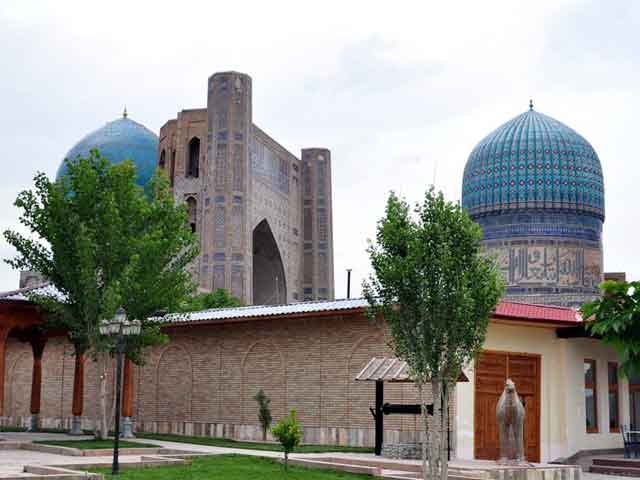Making Samarkand his capital, Amir Temur defined a concept of its revival as Imperial City.
Hugest arch portals and high blue domes expressed the status of the world city. Refined ornament from tiled majolica, geometrical ghirikh, linking stars, swastika with names of Allah, Prophet and Islamic best wishes. On the death of Amir Temur, Samarkand conceded rights of the imperial capital to Herat. During the 15th century, Samarkand was the capital of Mirzo Ulug Beg, the outstanding king and scientist, and then - of the Temurid governors, which were under influence of Sufi sheikh Khodja Akhrar.
At the end of the 15th century, Shaybani Khan from the Genghisids interfered in a struggle for Temurid heritage. He consolidated the Uzbek tribes and headed the struggle for Maverannahr. In 1499-1500, he took Samarkand and Bukhara. The Temurid, Babur managed to beat back Shaybani Khan for a while, but at last was defeated. Shaybani Khan abolished the power of the Temurids and established the state with the capital in Samarkand. The Shaybanids had been governing in Central Asia for the 16th century. In 1533, the capital was transferred to Bukhara - a center of spiritual influence of "naqshbandiyyah" Samarkand became the second city in Bukhara khanate At the end of the 16th century, at Abdullah Khan II, Bukhara khanate included Maverannahr, a significant part of Khurasan and Khorezm, that corresponded to a "nucleus" of Amir Temur’s state. In the 17th and the first half of the 18th cc., the Shaybanid dynasty was replaced by the Astarkhanids (1601-1747).
Invasion of Iranian Nadir Shah and governing of his rulers (1740-1745) caused catastrophic desolation of Maverannahr and Khorezm. The loss was so great, that Samarkand should have been peopled anew in account of migrants from the other cities. Through agency of Nadir Shah, the power in khanate was transferred to the dynasty of Manghit emirs, reigning till 1920. In 1868, Russia declared war to Bukhara emirate, Samarkand was annexed without fight. According to peace treaties from 1868 and 1873, Bukhara khanate recognized protectorate of Russia, and Samarkand became one of regional centers of the Turkestan general-governorship. Civil war in Russia after revolution of 1917 brought to liquidation of Bukhara khanate in 1920 and to establishment of the Uzbek Soviet Socialist Republic in 1925. Samarkand had been its first capital up to 1930. After collapse of Soviet Union in 1991, the sovereign Republic of Uzbekistan. Today, Samarkand is a regional center and one of the major tourist centers of Uzbekistan was established.


